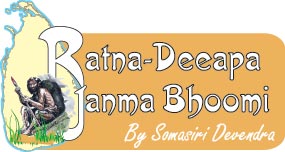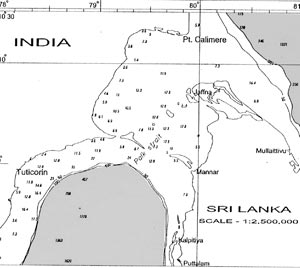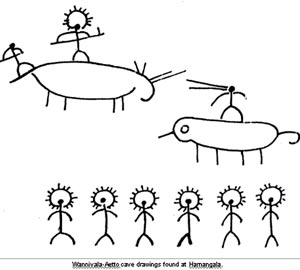In Part 1 we saw that, during 80% of the last 100,000 years (or 80,000 years), Sri Lanka was not an island but part of the Eurasian mainland. There was no India, no Palk Strait, and no Sri Lanka. Animals and humans roamed at will over this large landmass, constrained only by such things as the physical features, climate, vegetation, availability of food, vulnerability to danger: in short, whether the land was capable of sustaining them. Humans had not yet evolved into sizeable communities, or settlements, but were only small groups of hunter-gatherers. Those of them who came to this southernmost part of Eurasia would have wandered about in small family groups within limited areas, and been driven to move away only by changes in their chosen environment, and not by plan.
 |
Several groups could have moved to some particular area, if some change of environment, or other factor affected them either favourably or unfavourably. Dr. Siran Deraniyagala has suggested that, since the environment of southern “India” was more favourable for human settlement, the more competitive, or aggressive groups may have forced less competitive groups to move further south, to “Sri Lanka”, which was a less attractive location. Whether this was, in fact, the case or not, these people could go no further that the southernmost coastline of the time.
Their wanderings would have lasted tens of thousands of years, and they may have wandered back and forth, between “India” and “Sri Lanka”, according to prevailing needs. There would have been great intervals between these many migrations: one group would have come to a particular area thousands of years before, or after, another and for different reasons. Some would have favoured the highlands, some the lowlands, some the sea coast. During the two short periods that Sri Lanka was an island (totalling only 20,000 of the 100,000 years) those who had settled by the sea would have gradually moved inland when the sea level inched upwards, and lived along the new coastline without even knowing that they did so. Any traces of their former settlements would, today, lie on our continental shelf, under the sea. Those who had settled in the highlands, however, never knew that the sea was rising or not, nor that they were “marooned”, and would have carried out their lives as before.
When this part of the mainland became an island, separated from the mainland by the sea (today’s “Palk Strait”), the migration of peoples between the two bodies of land came to a virtual stop.
It has been suggested that Man was technically capable of crossing the Palk Strait by rude rafts or floats but, at best, this would have, been an option available only to communities already settled on either side of the Strait belonging to a common culture and life-style: in fact, this sort of seagoing by sophisticated log raft (what we call “kattumaram” and “theppam” today) continues to date. This type of seafaring could not have been an important factor in migration, for reasons too lengthy to explain here. Thus, by and large, the physical separation of the two landmasses would have, at the very least, reduced the incidence of migration drastically.
Much more important is to recognize that the people who were stranded here by, and far away from the rising sea – people who neither could, nor needed to sail the seas – became, in fact, our real ancestors; the “First Peoples” of Sri Lanka. Of course they were the same people as those beyond the Strait but, when we became an island, it is they who became our ancestors. They left us no written records about themselves but, unknowingly, they left behind clues for us to ponder on – about themselves, and about us, their descendants.
Who were they, our ancestors? What do we know of them? When did they come? What did they look like? What did they eat? Where did they live?
And, most importantly – did they leave within us a part of themselves, in “the intricate dance of DNA, in the twisting molecular rivers of memory”?
The Pre-historic people
We began to scientifically study our pre-history quite recently and that, too, on a limited scale: so we do not have a complete picture these people. History gives us no answers, for it depends only on in written records. But Science has provided us with tools to use and draw credible conclusions that can be tested. Today, the study of early Man and his environment is not the province of historians, but of scientists who study material remains. What we have found, using those tools, have been compared with similar studies done in southern India, for the people on both sides of the Palk Strait were the same, separated only by the rising sea. Even then, we have only glimpsed the tip of the iceberg: there is much more for us to discover.
The sea-level today, as we have already noted, is higher than it had ever been in the last 100,000 years. This accounts for the shape and size of this island today. But, farther back in time, this land had been an island nine times during the last 800,000 years, the last time being about 120,000 years ago. Each time this happened, the sea-levels had been lower than today and those islands had been much larger island than ours (as Marco Polo recorded). The “Palk Strait” is a narrow and shallow body of water even now: in those times it would have been narrower and shallower. Just as when we were part of the mainland, those who wanted to come or go from those islands could have wandered here on foot, wading through the shallow waters.
 |
They would have walked along the flattest land, as that was the easiest thing to do. Their routes must have been the safest they could find, avoiding the forests where there were carnivorous animals, as early Man was, himself, hunted just as he hunted smaller animals. The gem-pits of Ratnapura have yielded evidence of these animals: fossil remains of the hippopotamus, the lion, and the rhinoceros. Most settlements, however, would have been near the sea. They had hunted small animals, tree snails etc. and caught lots of fish, and other “seafood”. Their “quality of life” would have depended on their technology; the degree of sophistication of the weapons and tools they could make.
Strangely, the largest and most sophisticated stone tools found in Africa, Europe and Asia have been found in North India, but not in South India or Sri Lanka. We do not know why: perhaps we might find out later. One the other hand, however, there is something special about certain stone tools found here in large quantities: they are very small, made of quartz and very beautiful: “like gems”, as archaeologist Siran Deranaiyagala described them. These little stone tools, or “microliths”, appear in other countries only about 19,000 years later. Why? Again, the answers will emerge later on. This sort of search never ends. We cannot even be sure that they were made for use as tools or for some other – perhaps ritualistic – purpose.
When the sea-level rose gradually, over thousands of years, the settlements of coastal dwellers were submerged and are now beyond us, for study. Other settlements, on higher land have, however, been found by archaeologists. The oldest settlements discovered are in the coast of Bundala-Wellegangoda, (125,000-80,000 years old), and at Pathirajawela, (125,000-75,000 years old). The evidence is only early stone tools and weapons. Since the excavations were limited in size, all we only know for now is that they were probably ‘anatomically modern’ humans; and that they were hunter-gatherers. As such they did not practise agriculture but existed on what they hunted or whatever fruits, nuts, leaves and roots they gathered from the forest. Their settlements were small; each group would not have had more than a few families. Food would have been more plentiful along the coast, particularly in the northern and eastern coasts, where there could have been bigger settlements. But we have not yet found any evidence.
Other, later, settlements discovered are much nearer us in time – 37,000 years ago, or nearer. We have more information about these people, because they lived in caves on higher ground, in what is now the “Lowland Wet Zone”. They had lived in caves for many generations, and they buried their dead also in the caves: so their remains have been protected. Pieces of their bones have been found and we are certain that they were “anatomically modern humans”. Because the first evidence was found in Balangoda, we have coined a name for them, “Balangoda Man”.
The places where their remains have been studied are: Fa Hien-lena or Pahiyangala (near Bulathsinhala, occupied from 37,000-5,400 years ago), Batadomba-lena (near Kuruwita, from 31,000-11,500 years ago), Beli-lena (at Kitulgala, from 30,000-3,500 years ago) and at Attanagoda, near Kegalle, (about 10,500 years old). As the Sinhala word “lena” indicates, these are all caves. But an open-air site was also found at Bellanbendi Palassa, near Embilipitiya (about 6,500 years old). Although these bone fragments older than 18,000 years ago show that the people were anatomically modern, genetic studies cannot be done because the bones are too fragmented. But, from newer remains - from 18,000 years ago to 6,500 years ago – genetic information has, however, been found.
 |
What do these studies show? Interestingly, they show that Balangoda Man was genetically connected to the most recent of the real Veddahs, who lived up to the 20th century, and whose skeletal remains are preserved in European museums. So the Veddahs can be traced back to at least 18,000 years ago: they are our oldest people – our “First People”. We should, of course, accord them the respect that is their due but, unfortunately, we do not.
What was Balangoda Man like? From the skeletal remains we estimate that the males were about 174 cm (5’7”) tall and the females about 166 cm (5’4”), which compares favourably with our own size. Their bones are ‘robust’ (hard and strong), their skull-bones thick, their eyebrow ridges are prominent. Their noses were depressed and spread wide, their jaws heavy and their necks short. Their teeth were definitely large. Some of these features are found among the Veddahs, and even certain Sinhalese groups, today.
This is not a full picture of our ancestors, as our material is limited. We still cannot say that only Balangoda man lived here in those days. Different people could have moved to and fro during the last years when Sri Lanka was part of the mainland. We need much more evidence.
Balangoda man seems to have lived in many areas in this country: the arid lowlands of Mannar and Wilpattu, the equatorial forests of Sabaragamuwa and even the damp, cold high plains of Maha-Eliya (“Horton Plains”). As was noted in Part 1, the climate, humidity and vegetation varied according to whether a “glacial” or “inter-glacial” period was prevailing: so these areas were very different from today at different times. They would have lived, more or less like the last forest Veddahs, moving from place to place foraging for food. In the caves, remains of a wide variety of food plants and animal bones have been found: nuts, fruits, yams and every variety of animals from snails and elephants to fish. This balanced diet may explain the strong bones.
They had stone tools of different shapes for different uses, and implements of bone and antlers. They had beads made of shell. From the large amount of seashells found and even of salt far inland, it seems that groups from different areas met and bartered (that is, exchanged) goods, which is an early form of trading. Beads made of shell have been found which may point to the use or ornaments. From fossil pollens discovered in excavations in the Maha-Eliya we know that they had maintained herds of cattle and goats and knew how to cultivate barley and oats. But they were, essentially, nomads, moving around in an area where the grass for the animals was available at different times of the year. They were still hunter-gatherers and we have little evidence of their pottery and no evidence of their using metal. So, although they had grown some barley and oats, they cannot be classed as farmers.
To complete the picture, we must consider the climate that prevailed at this time. Otherwise we cannot understand how people who moved along the coast-line left their remains up in the hills. Think again of the ice ages – for the ice caps to expand, water from the sea was converted into ice, causing the seas to shrink, sea-levels to fall and the very air to have less water-vapour. The climate became dry world-wide. In southern India, proof has been found that this part of the world became arid. Aridity resulted in changes in vegetation. It was this aridity that permitted our ancestors to grow barley and oats in Maha-Eliya – it was not then the cold, wet, misty Horton Plains we know, but more like the arid zone today. This was so till about 11,000 years ago: then, the climate began to gradually change. The ice-caps began to melt and shrink, and the seas began to rise. Just four thousand years later, about 7,000 years ago, the sea-level rose higher than it had ever done before, and we once again became an island. This time, it became the Sri Lanka of today.
Geologist Dr. Katupotha, has described the stages by which we became an island this time.
- From 11,000 years ago to 6,240 years ago, the sea level was rising.
(We became an island during this time)
- From 6,240 years ago to 2,270 years ago, sea-levels fluctuated: sometimes 1.5 metres higher than today and sometimes a little less.
(This fluctuation continued into Historic times)
- At 2,270 years ago, the sea-level became stable at today’s level.
(That is, some 175 years after the arrival of the legendary Prince Vijaya)
The people whose 37,000 year-old bone fragments we have found had continued to live here, as it was their home, whether it was an island or not. From the time the Palk Strait was formed – about 7,000 years ago – overland migration from the mainland ceased: though it is doubtful whether anyone noticed. If we are to accept the legends in the historical chronicles (i.e. the legend of Prince Vijaya), settlers came here by ship from the other shore more than 5,000 years later.
During these years, the “First peoples” had carried on as before, as nomadic hunter-gathers of the forests. It is reasonable to assume that the old and new settlers learnt to live together and inter-married (as said in the settlement legends of the Sinhala people).
As the settlers arrived in greater numbers (who they were is dealt with in Part 3) as time went by, the “First peoples” would have become very much a minority and the descendents of the mixed marriages would also have increased, but their genetic legacy – while yet extant – would have been considerably diluted.
Perhaps that is how, although the “First peoples” do not exist any more, we still carry their genes and, therefore, we are – to an extent – they. |




